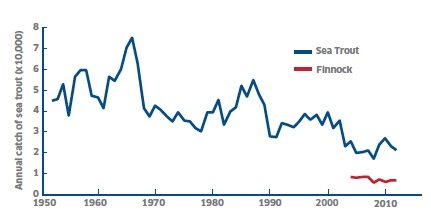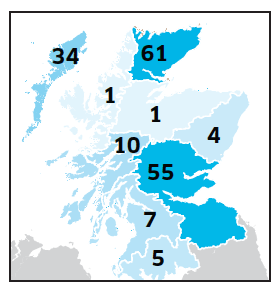Provisional Sea Trout Fishery Statistics - 2012 Season
Provisional sea trout fishery statistics are published to provide an early indication of the performance of the fishery. The status of sea trout stocks, largely as derived from fishery data, will be considered with the publication of the final statistics
// PROVISIONAL SEA TROUT FISHERY STATISTICS - 2012 SEASON
Summary
- For Scotland as a whole, total rod catch of sea trout (retained and released) for 2012 is 21,691. Catches have declined over much of the period since 1952, when our records began and the 2012 catch is the fifth lowest in the time series.
- The proportion of the total rod catch accounted for by catch and release remains among the highest reported since records began in 1994 and accounted for 70% of the catch in 2012.
- There are clear differences among geographic regions in the relative strength of the 2012 rod catch. All mainland regions in the west of Scotland reported catches which were within the lowest ten recorded for their region over the period 1952 to 2012. The reported catch in Moray Firth and North East regions were, similarly, the lowest and fourth lowest respectively over the same period. Catches in the East and North regions in 2012 were, on the other hand, both among the top ten catches recorded within their respective regions, while the catch recorded in the Outer Hebrides was close to the mid-point in the time series.
- Catch and effort for both fixed engine and net & coble fisheries remain at historically low levels. Reported catch in each fishery was 2,426 and 2,682; 4% and 1% of the maximum reported in the respective time series. Fishing effort in these fisheries was 236.5 trap months and 78.5 crew months; the fifth and sixth lowest, respectively, since records began in 1952.
- Provisional data presented here are a summary of the data from 1,823 forms returned from 2,016 forms originally issued (90% return rate) for the 2012 season. Return rates for the final published statistics for the previous 10 years have been between 93% and 96%.
Publication of provisional sea trout fishery statistics
Provisional sea trout fishery statistics are published to provide an early indication of the performance of the fishery. The status of sea trout stocks, largely as derived from fishery data, will be considered with the publication of the final statistics later in the year.
These data are derived from a lower proportion of forms returned than the final statistics. The provisional statistics for the 2012 season are a summary of the data from 1,823 forms returned from 2,016 forms originally issued (90% return rate). Return rates for the final published statistics for the previous 10 years have been between 93% and 96%.
Topic sheet no. 67 explains how we collect the catch statistics and is available for download at http://www.scotland.gov.uk/Topics/marine/science/Publications/TopicSheets/tslist
Provisional data for the 2012 fishing season are available for download by following links from the main Scottish Salmon and Sea Trout Fishery Statistics page at http://www.scotland.gov.uk/Topics/marine/science/Publications/stats/SalmonSeaTroutCatches
The data provided for download are the best available at the time of publication. Our records are amended when further information is provided and the most accurate data may be obtained directly from us. If you have a specific request for Scottish salmon and sea trout fishery information, please contact us directly at ms.catchform@scotland.gsi.gov.uk
// Catch & Effort Reported by Scottish sea trout Fisheries in 2012
The rod and line fishery
6,410 sea trout were reported caught and retained in the rod and line fishery. A further 15,281 sea trout were reported caught and released. We have no comprehensive time series of fishing effort information associated with the rod and line fishery.
Total rod catches (retained and released) of sea trout for Scotland as a whole have declined over much of the period since 1952, when our records began, and the 2012 catch is the fifth lowest in the time series (Figure 1).

Figure 1
Rod and line fishery.
Finnock are sea trout which have spent only a few months at sea before making their first return to fresh water. They may also be known as whitling or herling. Finnock catches have been reported since 2004 and are not included in the sea trout data summarised above. The total rod catch of finnock in 2012 was 7,079 which equalled the previous 5-year average (Figure 1).
Catch and release
The proportion of the rod catch accounted for by catch and release has shown a general increase since 1994, when catch and release information was first recorded. In 2012, 70% of the rod catch was released compared to 8.5% in 1994.
Comparison of catches among geographic regions
Analysing the catch data at finer geographical scales reveals differences among regions in the relative strength of 2012 catches compared to available historical data. Annual reported rod catch (retained and released) for each region was ranked over the time series from 1952 to the present (1=lowest, 61=highest) (Figure 2). Orkney and Shetland have been omitted from this regional analysis as they are not considered to have been fully covered by the survey over much of the time series.

Figure 2
Relative strength of 2012 rod catch among
regions.
All mainland regions in the west of Scotland reported catches for 2012 which were within the lowest ten recorded for their region over the period 1952 to 2012. The reported catch in Moray Firth and North East regions were, similarly, the lowest and fourth lowest rercorded over the same period. Catches in the East and North regions in 2012 were, on the other hand, both among the top ten catches recorded within their respective regions over the same period, while the catch recorded in Outer Hebrides was close to the mid-point in the time series.
The net fisheries
2,426 sea trout were reported caught and retained in the fixed engine fishery. The national index of fishing effort was 236.5 trap months. 2,682 sea trout were reported caught and retained in the net & coble fishery and the reported effort was 78.5 crew months.
Reported catch and effort have declined in both net fisheries over much of the period covered by our records and remain at historically low levels. Catch in the fixed engine and net & coble fisheries were 4% and 1% of the maximum recorded in the respective time series. Fishing effort in these fisheries was the fifth and sixth lowest, respectively, since records began in 1952.
Contact
There is a problem
Thanks for your feedback